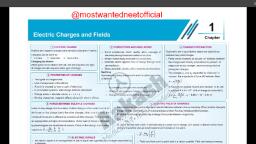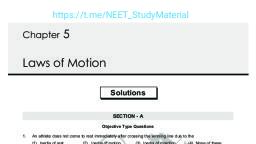Page 1 :
Chapter 7, , System of Particles and, Rotational Motion, , Chapter Contents, , e, , Introduction, Centre of Mass, Motion of Centre of Mass, , Linear Momentum of a, System of Particles, , Vector Product of two, Vectors, , Angular Velocity and its, Relation with Linear, Velocity, , Torque and Angular, Momentum, , Equilibrium of a Rigid Body, Moment of Inertia, , Theorems of Perpendicular, Axes and Parallel Axes, , Kinematics of Rotational, Motion about a Fixed Axis, , Dynamics of Rotational, Motion about a Fixed Axis, , Angular Momentum in Case, of Rotation about a Fixed, Axis, , Rolling Motion, , Chapter in Daily Life, , Some Important Definitions, Formulae Chart, , Quick Recap, , Introduction, , Have you ever seen carefully the motion of wheel, gears, motors,, blades of the helicopter etc. They all exhibit a similar and special kind, of motion that is “rotation”. Rotation of earth about its own axis, creates the cycle of day and night. So far in our previous chapters, we have discussed the translation motion of objects. In pure, translation motion all the particles of the object have the same, velocity at any instant of time therefore, the object can be considered, as a point object. But consider the rotational motion of a wheel., We cannot consider a wheel as a single particle because different, parts of the wheel in motion have different velocities and acceleration., , To simplify our study of rotational motion, we consider extended, bodies as rigid bodies. Ideally a rigid body is a body with a definite, and unchanging shape. Since real bodies deform under the influence, of forces therefore, no real body is truly rigid. But in many situation, such as wheels, tops, steel beam etc the deformations are negligible, and can be ignored and treated as rigid. Here in this chapter we will, consider rigid bodies having definite shape and size, and capable of, having both rotational and translation motion. To understand the, rotational motion as a whole, we are first require to understand the, concept of angular position, velocity, acceleration ete. But in this, chapter we begin with the consideration of motion of the system as, a whole ie., the key concept of “centre of mass". Then we shall, discuss the motion of the centre of mass of a system of particles and, usefulness of this concept in understanding the motion of extended, objects. Then we will define rotational motion and generate variables, to describe that motion. Next, we shall develop the kinematic, equations relating these variables. Though the mathematics of, rotational motion might be a bit more complex, the concept behind, it are quite similar to that of linear motion., , Aakash Educational Services Pvt. Ltd.-Regd. Office: Aakash Tower, 8, Pusa Road, New Deihi-110005 Ph.011-47623456
Page 2 :
198 System of Particles and Rotational Motion Board & Competitive Exams., , CENTRE OF MASS, , The concept of centre of mass of a system enables us, in describing the overall motion of the system by, replacing the system by an equivalent single point, where the entire mass of the body or system is supposed, to be concentrated., , , , , , Now let us try to find out the centre of mass of a two particle system in one, two and three dimensions., Consider two particles of masses m, and m, lie in a straight line at positions x, and x, from the origin (O), as shown below,, , , , The position of centre of mass (C) from the origin is given by, x = THX + MAX, Ty tay, If the two particles have same masses i.e. m, = m, = m (say) then,, X + Xe, 2, , i.e. the midpoint of the line joining m, and m,. Thus, for two particles of equal masses the centre of mass, lies exactly midway between the straight line joining them., , Now, suppose we have a system of n particles of masses m,, m,, mM, ... m, respectively along a straight, line at distances x,, x,, X,...x, from the origin respectively. Then the centre of mass of the system is given, by, , mx,, , , , X = AG + MX + IM Xy, m+m, +t — >m,, a, , , , The symbol d lthe Greek letter sigma) denotes summation, i.e. this case over n particles, , =m=M, am, where M is the total mass of the system., , Now, suppose these two particles m, and m, are not lying along a straight line, rather they are lying in, (x. y) plane. So, they will have x and y coordinates for their respective positions in the plane. Let (x,. y,) be, the coordinates of m, and (x,, y,) be the coordinates of m,, shown in the figure given below., , , , Aakash Educational Services Pvt. Ltd.-Regd. Office: Aakash Tower, 8, Pusa Road, New Delhi-110005 Ph.011-47623456
Page 3 :
Board & Competitive Exams. System of Particles and Rotational Motion 199, The coordinates (x, y) of centre of mass is given by., , a, “mem ‘> m+m, , , , x,, If both the masses m, & m, are equal then, x =, , ath, C=, , Thus, for two particles of equal mass in a plane, the centre of mass lies exactly on the midpoint of the line, joining the particles. Now if n particles of masses m,, m,, m,...m, having coordinates, (x,, Y,), (x. Ya). ---(X», y,) lie in a plane, then the coordinate (x, y) of the centre of mass is given by, , yma,, , y= TAK + TX + MX y _, m,+m,+..m,, , , , , , ¥, , , , m, +m, ...m,, =m, , n, zm = M, where M is total mass of the system, , , , , , Now, if these n particles, do not lie in a plane, rather distributed in space, then each particle will have a (x,, y, Z) coordinate and in that case the coordinates (x, y, z) of the centre of mass of the system is given by, , , , , , , , a £. a, , Sx, zm mm, x= y= M and z= M, We can also use position vector of particles in space to give the position vector of the centre of mass of, the system, , ri=xit+ty)+zk, , 7, §s the position vector of particle m,, combining the above equation, we get fF = x,i+y,j+zk, , where 7; is the position vector of i” particle., , , , The position vector R of the centre of mass is given by R = xi+yj+zk = 7, Now, if the centre of mass of the system lies on the origin then, the position vector R is zero, ie. Ff, = 6 for the given system of particles., , m, , Aakash Educational Services Pvt. Ltd.-Regd. Office: Aakash Tower, 8, Pusa Road, New Delhi-110005 Ph.011-47623456
Page 4 :
200 System of Particles and Rotational Motion Board & Competitive Exams., , A rigid body, such as a metre stick or a fly wheel, is a system of closely packed particles and the number, of particles in such a body is so large that it is impossible to carry out the summations over individual particles, in these equations, and as the spacing between the particles is very small therefore, we can treat the body, as a continuous distribution of mass., , Let us divide the body into n small elements of mass Am,, Am,, ...Am,; then the coordinate of the centre of, mass are approximately given by, , xe hme Lamy, 1 Amy,, “Lam 7° Sam, 7° Sam,, , As we keep on increasing the number n, the Am becomes smaller., , Thus we can replace the summation () sign by integral i.e., > Am —> fan =M => total mass of the body, , >(4m,)x, > Jxam, , Xlam)y, > fyam, , X(am,)z,> Jzam, The coordinates of the centre of mass now becomes, , 1 1 1, = Jxam, 7) Jyam ana z-G fzam, , The vector expression for the centre of mass equivalent to above three expressions is, , sag A ps, , R=G fram, If we choose the centre of mass as the origin of our coordinate system then, R =0 i.e., the position vector, of the centre of mass is zero., , Centre of mass of uniform Laminar objects, , A laminar object means a two dimensional distribution of mass of negligible thickness e.g., paper of your, copy. If a large number of laminar type objects are placed in a plane then, , , , , , = ViAn + Y2A2 +--+ ¥nAn _ EVA,, Ay + Ag+... + An =A,, , where A represents the area of laminar objects, , , , Yom, , , , Example 1: A disc of radius r is cut from a larger disc of radius 4r in such a way that the edge of the hole, touches the edge of the disc. Locate the centre of mass of the residual disc., , Solution : Method- | : Figure shows the point C as the centre of the whole disc. C, is the centre of the, hole and C, is the centre of mass of the residual disc. If m be the mass of the disc cut from, the larger disc, then mass of the whole disc is 16 m, because mass of a disc varies as the, square of its radius., , So, the mass of the residual is m, = 16 m—m=15m, , Aakash Educational Services Pvt. Ltd.-Regd. Office: Aakash Tower, 8, Pusa Road, New Delhi-110005 Ph.011-47623456
Page 5 :
Board & Competitive Exams. System of Particles and Rotational Motion 201, , Clearly, C is the centre of mass of two masses m, = m and m, = 15m at C, and C, respectively,, where CC, = 4r—r= 3r= x, (say). Let CC, = x,. If we take C as the origin, then x,,, = 0., , Now using x, = MH%1+ MaX2 | we get o = M+ Mal-x2) iY, on my +m, m, +m, i, i, , or,, , _ MX, _ (m)(3r) _, oS nen 6 oe, , 2X2 |, Remember as formula, , , , , , XA, — X2A2, AA,, where A, is the area of original object and A, Is the area of removed part., Here A, = 161 7°, A, = nF, x, = O and x, = 3r, , Method- Il : We may also use formula xcy =, , Xen = OTST, , om “W6nr? — nr? 5, r, , ce, =F, , , , , , , , Centre of mass of Rigid Continuous Bodies, A rigid body may be treated as a continuous distribution of matter., , The “particle” then becomes differential mass elements "dm" and the summation (=) becomes integration, (). Hence,, , , , , , These integrals are evaluated for all mass elements in the object., , ———, Illustrations, , (a) Centre of mass of a uniform straight rod : Let us consider a uniform straight rod of length / and, , mass M. Take one end of the rod as the origin and the line along the length of the rod as x-axis., , Let us consider a small length dx of the rod at a distance of x from the origin. The mass of the small, , ‘ M, element is dm = 7 : Y, The x-coordinate of the centre of mass is, L, u 1 {x(Max|=1 °o—————, =— =— — =- x, Xem uM Je dm M f( 7 ax) 1 Fe dx oe, , , , Aakash Educational Services Pvt. Ltd.-Regd. Office: Aakash Tower, 8, Pusa Road, New Delhi-110005 Ph.011-47623456











































































